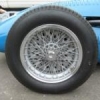Here's an old GM engine durability test. Doubtless Ford's is similar
This is excerpted from an article by a former GM employee, Max Freeman. It was written for Contact Magazine, which is devoted to the conversion and operation of automotive and non traditional powerplants for aircraft:
"As a routine part of an engine development program we tested the engine at full power, maximum RPM. We ran it at 6000 RPM, pulling 215 HP at wide open throttle, for 265 hours. That's a continuous 265 hours of wide open throttle, far worse than autobahn driving, because even on the German Autobahn, you wouldn't be at 6000 RPM. That is a standard durability test. We run many engines through this test as a matter of course.
Specific development focus is on the crank, pistons, rods, block structure, timing drive wear; we get a lot of full load cycles in a hurry. It isn't necessarily designed to replicate customer driving but to get development answers. Wear and fatigue are accelerated. The test is particularly applicable in proving out dampers and their effectiveness. If the damper is not properly tuned to the engine the crankshaft will inevitably break in that time period.
A number of other engine tests are utilized. We use a variety of specific tests to accelerate engine wear and to look at fatigue failures. The cyclic endurance test is now called PTED (power train endurance). It closely approximates cyclic durability. The engine is cycled from its torque peak to its horsepower peak, at wide open throttle, then down to idle, then accelerates up to shift points, then back down to the torque peak and then horsepower peak. This test is run for 400 hours. Once again, it's a wide open throttle test for 400 hours. The RPM for this engine, ranged between 4400 and 6000 RPM, back and forth in about a 5 minute cycle. The dyno computer will occasionally bring the engine down to idle, up to 6500 RPM shift points, and then back to the 4400 - 6000 RPM 5 minute cycle.
Thermal cycle tests are run to define engine capability under cold weather condition. We run the engine at full throttle at 4000 RPM, bring it down to idle, stop it, switch the coolant valves to drain the hot coolant, pump the chilled coolant from the chiller until the metal temperature stabilizes at 0 degrees F. Frost forms on the outside of the block, as the cold coolant rushes into the engine. When it stabilizes at 0 F, we motor the engine, start it, come to full throttle at 4400 RPM, the valves switch and the coolant temperature starts to climb. It climbs back up to 260 degrees F. It takes 10 -11 minutes to complete one cycle. The engine must pass 600 cycles without any sign of failure. We typically run 1200 cycles and a probe test will run 1600 cycles. That's a (sic) excellent gasket killer test. Head gaskets are the first to fail because of the rapid expansion and contraction.
A powertrain endurance test simulates in-vehicle operation. The Ypsilanti plant uses it for testing transmission. We, of course, use it to look at engine performance. The equipment consists of an engine/transmission combination, which sits on a dyno with large steel inertia wheels. The inertia wheels are being driven by the transmission output shaft, just like in a car. They cycle is brutal; the engine is at idle in gear. The engine accelerates wide open to 6200 RPM, upshift occurs, 6200 RPM is reached, upshift occurs to 3rd, 6200 RPM is reached, upshift occurs to 4th, the wheels turn up to 135 MPH depending on the application. The second half of the cycle calls for a closed throttle down to 70 MPH, then wide open throttle with a downshift to 2nd, the engine goes back up to top speed, coasts down so that the transmission selects down to a lower range. The engine is in an overrun condition all the way down to idle; i.e., the engine is being used for braking. That's one cycle. One transmission life cycle is typically 12K - 13K cycles of the above test. We will run an engine through 4 or 5 transmissions. This is a very harsh schedule for the engine, particularly because of the overrun braking.
Cylinders and rings suffer the most on this test.
We run some idle tests to verify low speed operation. The engine is run at idle for about 2000 hours to make sure of adequate oil flow at idle.
We use all those engine tests in addition to fleet tests and extensive vehicle road testing. The customer can be assured that the PV6 engine is a thoroughly tested advanced design that matches or exceeds competing offerings."





















